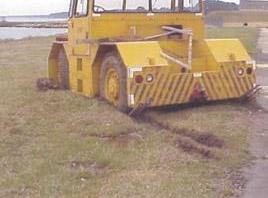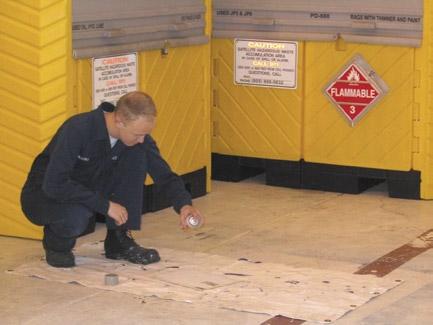
6 minute read
Mudding in Maryland
from MECH Fall 2006
By AT2 (AW) John SraderBy AT2 (AW) John Srader

Advertisement


It was a beautiful, sunny day, and my shop, work center 210, had line duties for the week. Maintenance control called and directed us to move aircraft 774 down to the sea wall for ground testing. This great day was about to turn dark and ugly.
We organized the move crew and towed the aircraft out of the hangar and down the flight line. As we continued along the taxiway, we were told to hold short of all active runways and wait for several aircraft to take off. After a 20-minute wait, the tower directed us around the airfield for what seemed like a tour of the base. Finally approaching the sea wall after a long, convoluted tow, we met the rest of the move crew.
Even though I have over five years experience towing P-3s, this was my first aircraft tow to this side of the base. I had no experience towing on such a narrow ramp—the fighter area on base.
The taxi director, a yellowshirt and second-class petty officer, was more familiar with the area, and I assumed he had done numerous aircraft moves to this side of the base. After the yellowshirt talked with the engineers about where they wanted the aircraft, we continued towing and came to a power island that ran down the center of the ramp. We started to make what looked to be about a 180-degree turn toward the sea wall, but the narrow constraints of the ramp area didn’t allow much space to make the sharp right-hand turn that was required to get the nose pointed seaward.
Everything had gone smoothly to this point, but I had a sinking feeling that I was going to have to pull onto the grass as the yellowshirt directed me forward.
Sure enough, the move continued, and I had pulled about halfway onto the grass before being directed to stop. After the tow bar was disconnected, I pulled the Buddha forward a little. With the back wheels no more than 6 inches off the ramp, I had that sinking feeling again, but, this time, it was for real. I immediately put the tractor in reverse, but it was too late. The 50,000- pound piece of equipment sunk right through the wet sandy ground like a hot knife slicing through butter.
I jumped out of the tractor before it was buried completely, and the rest of the move crew gathered around to make sure I knew what I had done. Another crew member jumped in and tried unsuccessfully to rock the tractor out of the mud. In fact, that action actually made it sink deeper.
To make a long story short, maintenance control was notified, and they contacted the air station’s public works department for a wrecker crew. A few hours later, they showed up with their wrecker and finally got the Buddha out. Of course, I wasn’t done, yet. The director and I were given some very effective EMI—we had to scrub down the Buddha before driving it back to the hangar.
As an experienced yellowshirt and tow-tractor driver, I should have known it would sink into the ground. We had received a lot of rain the day before, making the ground softer than normal. An on-the-spot risk assessment would have allowed us to take a second look at what we were doing and would have saved us a lot of trouble. I also had relied on someone else, instead of stepping up myself. I had become too lax and trusting.
I should have used the squadron’s “no vote” policy to stop the move [program allows Sailors to stop any evolution without a vote. — Ed.] and to do my own assessment, but I didn’t. I had assumed everything was fine, but it clearly wasn’t. I’ll never again assume anything. If you have that sinking feeling, trust your instincts.
Petty Officer Srader is assigned to VP maintenance division, Air Test and Evaluation Squadron Two Zero (VX-20), NAS, Patuxent River, Md.
By Anonymous Maintainer at VAW-117
The job was easy: Paint a metal sign for an air show. I took my materials, spray paint, a sheet of metal, and a drop cloth to keep the paint off the deck in the hangar. Sounds simple and should have been, but I ended up with the scare of a lifetime.
I began spraying the sign, making sure to get a good even coat. Unfortunately the wind blew some of the spray paint onto the deck, but it wasn’t a big deal. I knew I could just get some alcohol-based thinner and wipe up the paint. Again, it sounds easy enough. Well, apparently it wasn’t easy. As I began that job, I forgot the first principle everyone learns when they begin their career in naval aviation: De-FOD yourself before beginning a task.
As I scrubbed the deck and began getting up the paint, one of my friends came over to talk. I stood up and continued the conversation. This is when I realized my mistake. I had forgotten to remove my lighter out of my pocket. I didn’t think it was a big deal. I just would finish the job and take my lighter back up to the shop. It was small, and no one ever would know. That was my second mistake.


As my friend left to finish his work, I removed my hand from my pocket, accidentally pulling my lighter out with it. All it took was a small spark to ignite the alcohol thinner lying in puddles on the deck. Before I could react, the fire had spread to the entire six-foot area that had thinner on it. The flames were over my head! My panic and fear only heightened as the fire alarm went off and people began coming out of their shops to see what had happened. The last thing I heard walking out of the hangar was a loud pop as the AFFF stations went off.
The hangar AFFF system extinguished the fire before anything was damaged or anyone got hurt. Fortunately, the hazardous material containers, which were only seven feet away and full of paint, thinners and engine oil, did not ignite. Similarly, the fire didn’t reach an aircraft with an open fuel cell parked in the same hangar.
This whole problem could have been prevented with a simple check of my pockets for FOD before I began my task. I should have taken time to put the job on hold once I realized my lighter was in my pocket. FOD prevention is stressed so much, but I took a carefree attitude about it, thinking that it wouldn’t be a problem with me. My near-mishap is a simple example of how something so small can cause a serious problem in a heartbeat. I was fortunate things weren’t worse, and the incident cost only a little time and effort to clean up the AFFF in the vicinity of the fire. I’ve known people who would use a lighter to burn off excessive flammables, rather than wipe up the liquid and worry about disposing of the hazwaste. I hope that wasn’t the case in this incident. There’s only one way to do any job and that’s the right way. Shortcuts only lead to bigger problems.—Ed.










